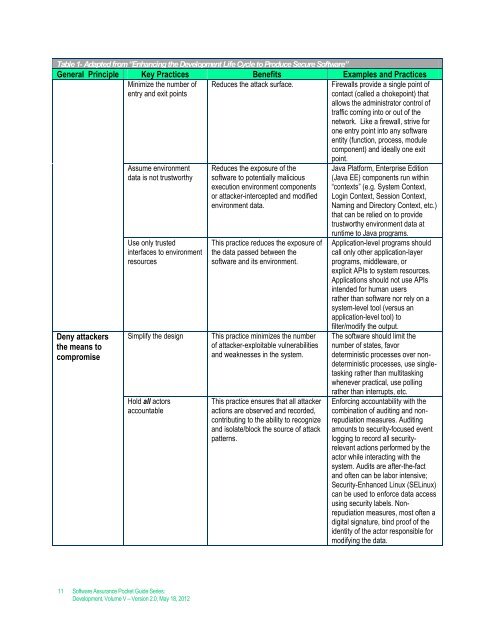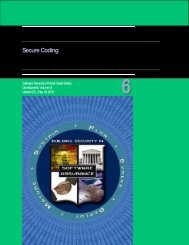Architecture and Design Considerations - Build Security In - US-CERT
Architecture and Design Considerations - Build Security In - US-CERT
Architecture and Design Considerations - Build Security In - US-CERT
Create successful ePaper yourself
Turn your PDF publications into a flip-book with our unique Google optimized e-Paper software.
Table 1- Adapted from “Enhancing the Development Life Cycle to Produce Secure Software”<br />
General Principle Key Practices Benefits Examples <strong>and</strong> Practices<br />
Minimize the number of<br />
entry <strong>and</strong> exit points<br />
Reduces the attack surface.<br />
Firewalls provide a single point of<br />
contact (called a chokepoint) that<br />
allows the administrator control of<br />
traffic coming into or out of the<br />
network. Like a firewall, strive for<br />
one entry point into any software<br />
entity (function, process, module<br />
component) <strong>and</strong> ideally one exit<br />
Deny attackers<br />
the means to<br />
compromise<br />
Assume environment<br />
data is not trustworthy<br />
Use only trusted<br />
interfaces to environment<br />
resources<br />
Simplify the design<br />
Hold all actors<br />
accountable<br />
Reduces the exposure of the<br />
software to potentially malicious<br />
execution environment components<br />
or attacker-intercepted <strong>and</strong> modified<br />
environment data.<br />
This practice reduces the exposure of<br />
the data passed between the<br />
software <strong>and</strong> its environment.<br />
This practice minimizes the number<br />
of attacker-exploitable vulnerabilities<br />
<strong>and</strong> weaknesses in the system.<br />
This practice ensures that all attacker<br />
actions are observed <strong>and</strong> recorded,<br />
contributing to the ability to recognize<br />
<strong>and</strong> isolate/block the source of attack<br />
patterns.<br />
point.<br />
Java Platform, Enterprise Edition<br />
(Java EE) components run within<br />
“contexts” (e.g. System Context,<br />
Login Context, Session Context,<br />
Naming <strong>and</strong> Directory Context, etc.)<br />
that can be relied on to provide<br />
trustworthy environment data at<br />
runtime to Java programs.<br />
Application-level programs should<br />
call only other application-layer<br />
programs, middleware, or<br />
explicit APIs to system resources.<br />
Applications should not use APIs<br />
intended for human users<br />
rather than software nor rely on a<br />
system-level tool (versus an<br />
application-level tool) to<br />
filter/modify the output.<br />
The software should limit the<br />
number of states, favor<br />
deterministic processes over nondeterministic<br />
processes, use singletasking<br />
rather than multitasking<br />
whenever practical, use polling<br />
rather than interrupts, etc.<br />
Enforcing accountability with the<br />
combination of auditing <strong>and</strong> nonrepudiation<br />
measures. Auditing<br />
amounts to security-focused event<br />
logging to record all securityrelevant<br />
actions performed by the<br />
actor while interacting with the<br />
system. Audits are after-the-fact<br />
<strong>and</strong> often can be labor intensive;<br />
<strong>Security</strong>-Enhanced Linux (SELinux)<br />
can be used to enforce data access<br />
using security labels. Nonrepudiation<br />
measures, most often a<br />
digital signature, bind proof of the<br />
identity of the actor responsible for<br />
modifying the data.<br />
11 Software Assurance Pocket Guide Series:<br />
Development, Volume V – Version 2.0, May 18, 2012
















